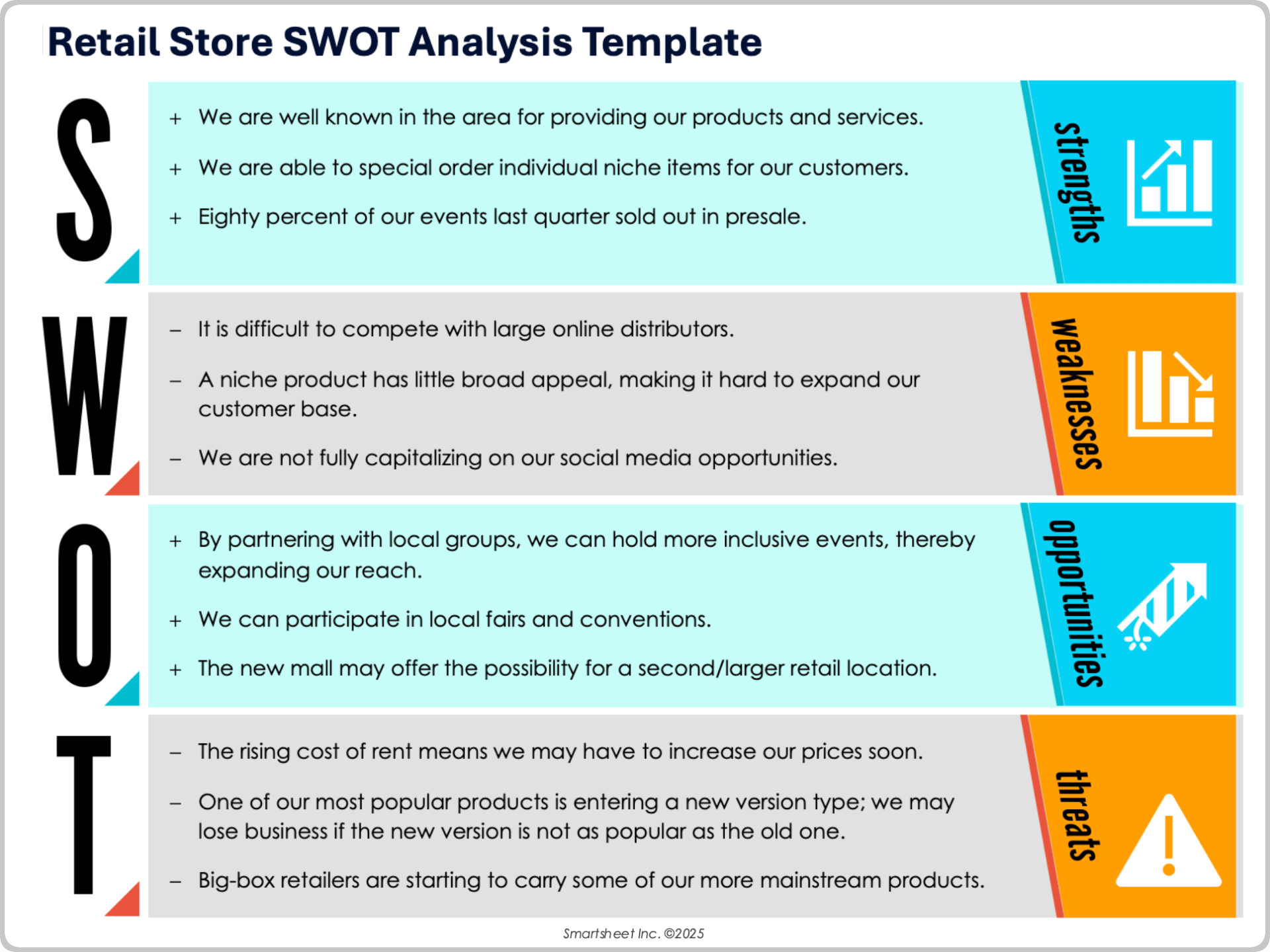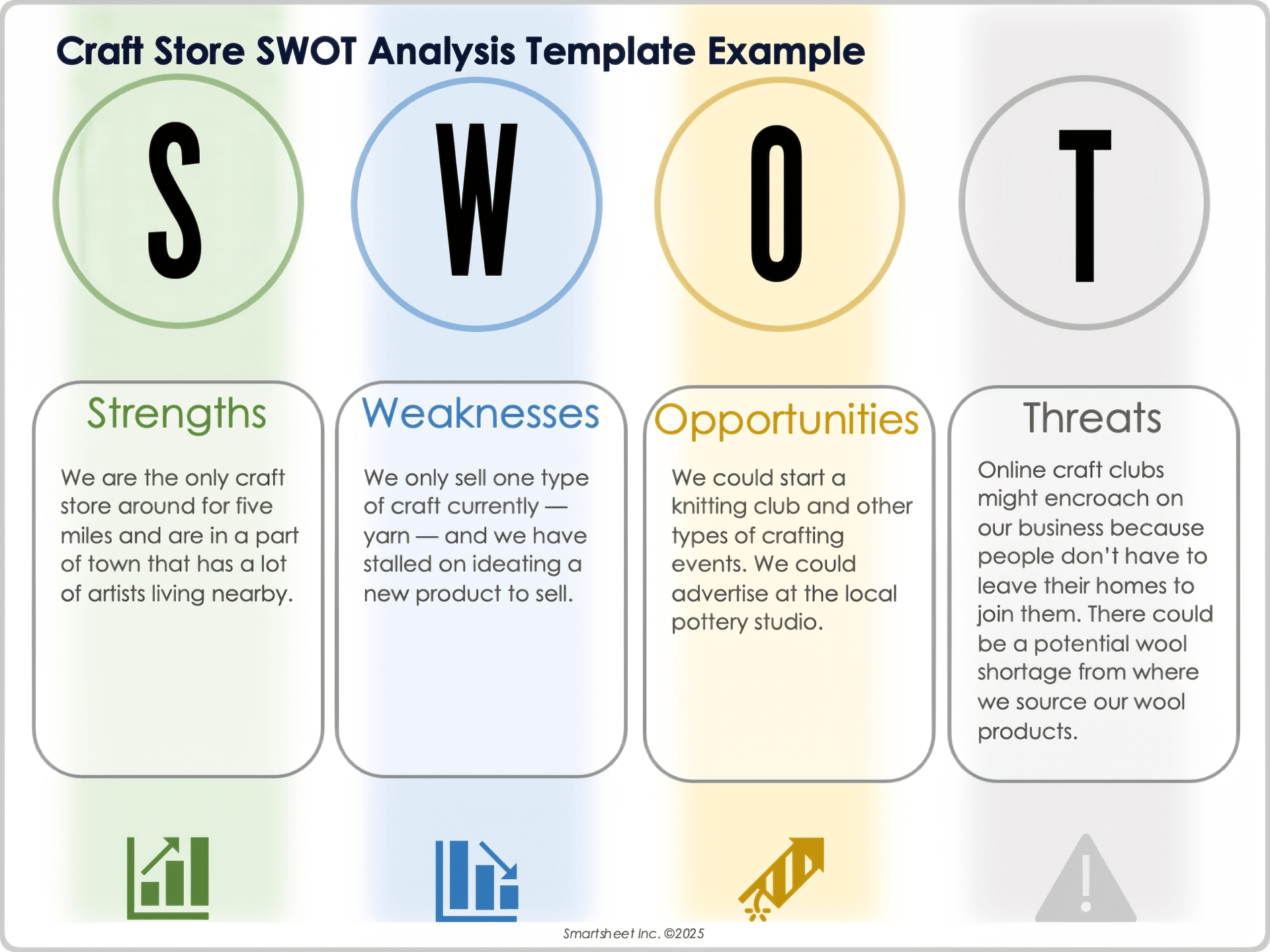How to Create a SWOT Analysis for a Small Business
Small businesses perform a SWOT analysis to improve and grow their business. The steps to create a SWOT analysis include gathering all team members, setting up your SWOT analysis grid, filling in the grid with your team’s expertise, and planning next steps based on your analysis.
- Set Objective
Define the goals of performing the SWOT analysis, whether it’s increasing profitability and growth, expanding into new markets, developing new products, improving efficiency, or managing risks or threats.
- Gather Key Stakeholders
As a small business, you have the advantage of being able to gather all your key stakeholders: owners, founders, employees, managers, or even customers. Every level of operations should be present.
- Set Up SWOT Analysis Grid
Create a grid divided into four quadrants. Label the quadrants Strengths, Weaknesses, Opportunities, and Threats.
Doing a SWOT analysis requires thorough discussion and examination to get a holistic understanding of all aspects of a business — and some aspects of a business can be positive and negative at the same time. “One of the most enlightening aspects of a SWOT analysis is the discussion that occurs as we go through each item,” says Jim Field, President of Wellspring Business Strategies. “I have facilitated more than one SWOT discussion where one member of the group will say, ‘That’s definitely a strength,’ and another will look at the same item and say, ‘I think that’s a weakness.’ The power of a SWOT analysis doesn’t come from simply doing a quick categorization; it lies in delving into each item, asking ‘why,’ and bringing underlying issues to the surface.”
- Fill Grid
Ask your employees and team members what they perceive to be the company’s strengths, weaknesses, untapped opportunities, and potential threats. Fill out each quadrant of the grid.
There are a few potential differences when performing a SWOT analysis for a small business as opposed to a large one. For example, a small business’s strengths and opportunities might lie in its ability to create a loyal base of repeat customers through personalized customer service, or its threats might include local market competition rather than global competition.
- Ideate Next Steps
After looking at your team’s ideas and suggestions, brainstorm the next actionable steps to improve or protect your business — leveraging strengths to create or capitalize on opportunities, or remedying weaknesses to reduce threats. Small businesses can be relatively flexible in converting ideas to actions quickly.
Eugene Day, an Agile Project Manager at NexGen Data Systems, says that it’s critical for small businesses to do honest assessments of their own strengths and weaknesses. “One of the best sources for this is your customers. Listen to what your customers say you do well and what you don’t do well,” he advises. “Instantaneous customer feedback is an advantage that a small business typically has over a larger business.” At the same time, he says, “a small business is inherently going to have more market influences (opportunities and threats) that are outside its control due to not having enough market share to influence the industry.”
Learn more about how to analyze your business with this guide to performing a SWOT analysis, and check out this collection of SWOT analysis templates to help you evaluate any business, project, or personal objective.
SWOT Analysis Questions for Small Businesses
The questions to ask in a SWOT analysis depend on the project or business. You should tailor the SWOT analysis for a small business to its context, product, and competition. When evaluating strengths or threats, you might focus on local competitors. When evaluating opportunities, focus on small-scale product feedback mechanisms.
Below are example questions that can help you analyze strengths, weaknesses, opportunities, and threats in the case of a small business.
- Strengths
- Example Question: What makes us stand out from local competitors?
- Example Answer: We love our product and genuinely believe in it. We devote a lot of capital toward marketing and getting the word out.
- Example Question: How does our customer service encourage repeat customers?
- Example Answer: Our response rate is very high, and our customer service is always provided by real people.
- Example Question: How is our product unique?
- Example Answer: Our product uses locally sourced ingredients and is produced in small batches, making it sustainable and flexible to customer preference.
- Weaknesses
- Example Question: Are there inefficiencies in our workflow?
- Example Answer: Yes, the supply chain sometimes has communication breakdowns since we have a small staff and rely on one supplier.
- Example Question: Do we have a process in place for logging critiques or suggestions for improving our product?
- Example Answer: No, we do not have a place where customers can give us feedback about the product.
- Example Question: In what ways are our competitors more successful than us?
- Example Answer: They have a strong local marketing strategy; we need to dedicate more time to researching local markets to find the best target audience.
- Opportunities
- Sample Question: Are there potential local markets that we haven’t tapped?
- Example Answer: Yes, we have not yet targeted younger consumers with our marketing.
- Sample Question: Can we partner with another company or influencer to increase brand awareness?
- Example Answer: Yes, we’ve seen influencers who use our type of product and we can reach out about doing a brand collaboration or event.
- Sample Question: Can we make our chain of command clearer?
- Example Answer: Yes, we can document our process with an organizational chart and hold regular meetings to ensure open communication channels.
- Sample Question: How well do we know our customers’ needs?
- Example Answer: We should conduct a survey with current and potential customers to better understand their needs.
- Threats
- Example Question: Is there a local competitor more successful than us?
- Example Answer: Yes — we can form a strategic partnership with them or focus on differentiation to target their customer base.
- Example Question: Are there any new regulatory changes that might affect our business?
- Example Answer: Yes, the TikTok ban will affect our marketing mechanism; we should aim to diversify our social media presence.
- Example Question: Are there potential threats on the horizon for our supply chain?
- Example Answer: Yes, the pandemic has disrupted our supply chain; we should consider alternate, local vendors.
Small Business SWOT Analysis Starter Kit
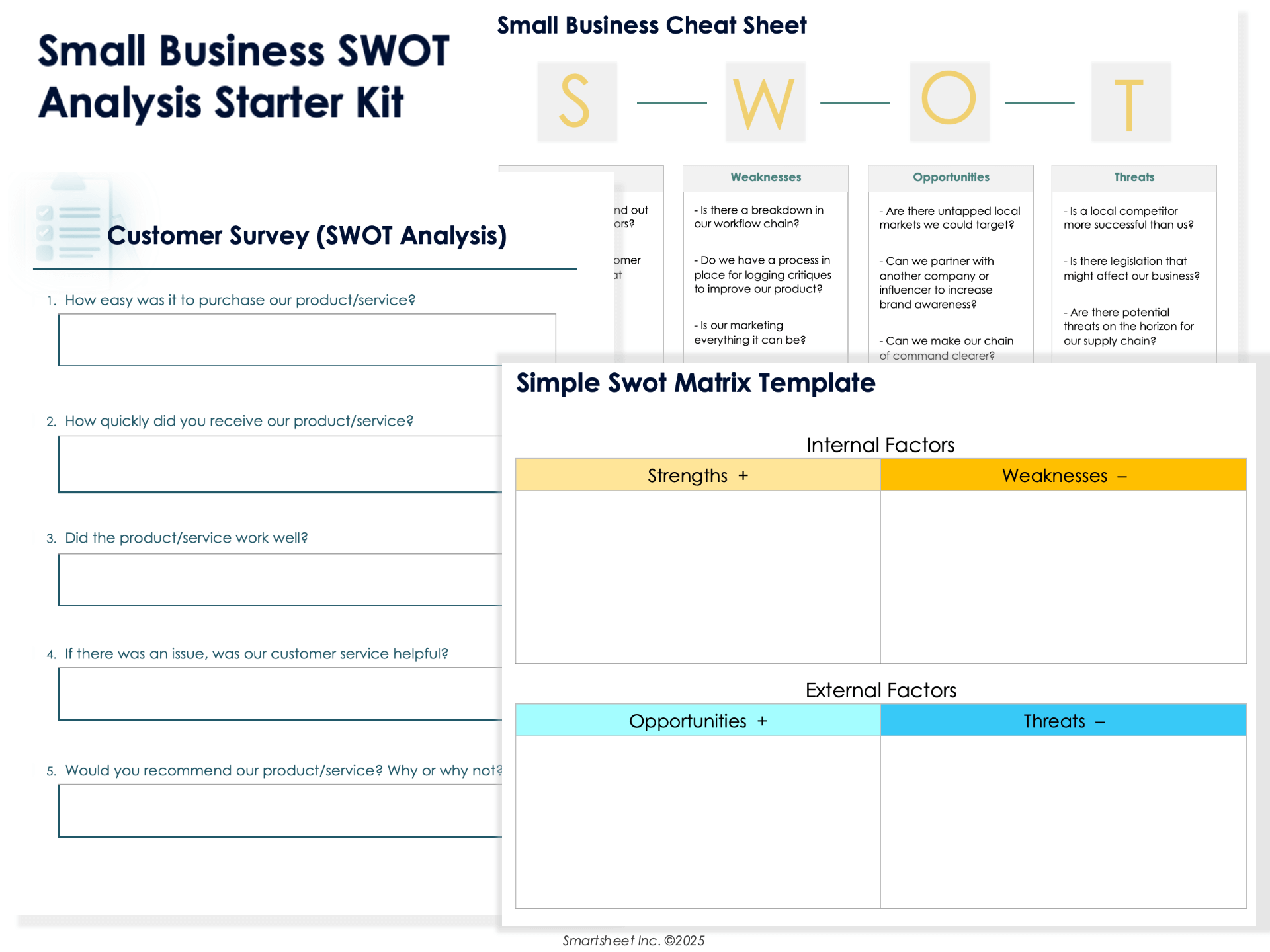
Download the Small Business SWOT Analysis Starter Kit
Use this free starter kit to help you conduct an informed and detailed SWOT analysis for your small business. This kit includes a SWOT analysis template and a sample customer survey.
In this kit, you’ll find:
- A blank SWOT analysis template for Microsoft Word
- A small business cheat sheet with sample questions for Microsoft Word to help you conduct your SWOT analysis
- A sample customer survey for Microsoft Word to help incorporate feedback into your SWOT analysis
SWOT Analysis Examples for Small Businesses
Below are SWOT analysis templates for different types of small businesses. We look at SWOT analyses for retail stores, craft startups, restaurants, tech startups, digital marketing agencies, and nonprofit organizations.
For Eugene Day, doing SWOT analysis with small businesses has revealed several insights. For example, when assessing its weaknesses, one business found that it was not able to leverage cost reduction though large volume purchases and required more effort and resources to penetrate new marketplaces. The threats to the business were a large company offering the same products or services potentially expanding into its market or price increases from suppliers that would have been difficult for a small business to negotiate or react to.
Check out this guide to budgeting for small businesses to improve your business’s financial health, and get your business on the right track for long-term growth with this complete guide to setting small business goals.
Retail Store SWOT Analysis Example
This retail store SWOT analysis demonstrates the strengths, weaknesses, opportunities, and threats associated with a small retail business. This business is able to order niche items for its customers but has a hard time competing with large online distributors. The owners have an opportunity to partner with local groups to expand their outreach, but the rising cost of rent is a threat on the horizon.
Download the Retail Store SWOT Analysis Template for Microsoft Word
Craft Store SWOT Analysis Example
This craft store SWOT analysis demonstrates the strengths, weaknesses, opportunities, and threats associated with a small craft business. The business is well located, but only sells one type of craft. There is an opportunity to organize a craft club and other events, but there is a potential materials shortage that could be a threat.
Download the Craft Store SWOT Analysis Template for Microsoft Word
Restaurant SWOT Analysis Example
This restaurant SWOT analysis demonstrates the strengths, weaknesses, opportunities, and threats associated with a small restaurant business. The owners have a strong history of running successful restaurants, but this menu has too many items on it to guarantee excellence for all of them. The owners have an opportunity to collaborate with food influencers but new construction outside the building is a potential threat to foot traffic.
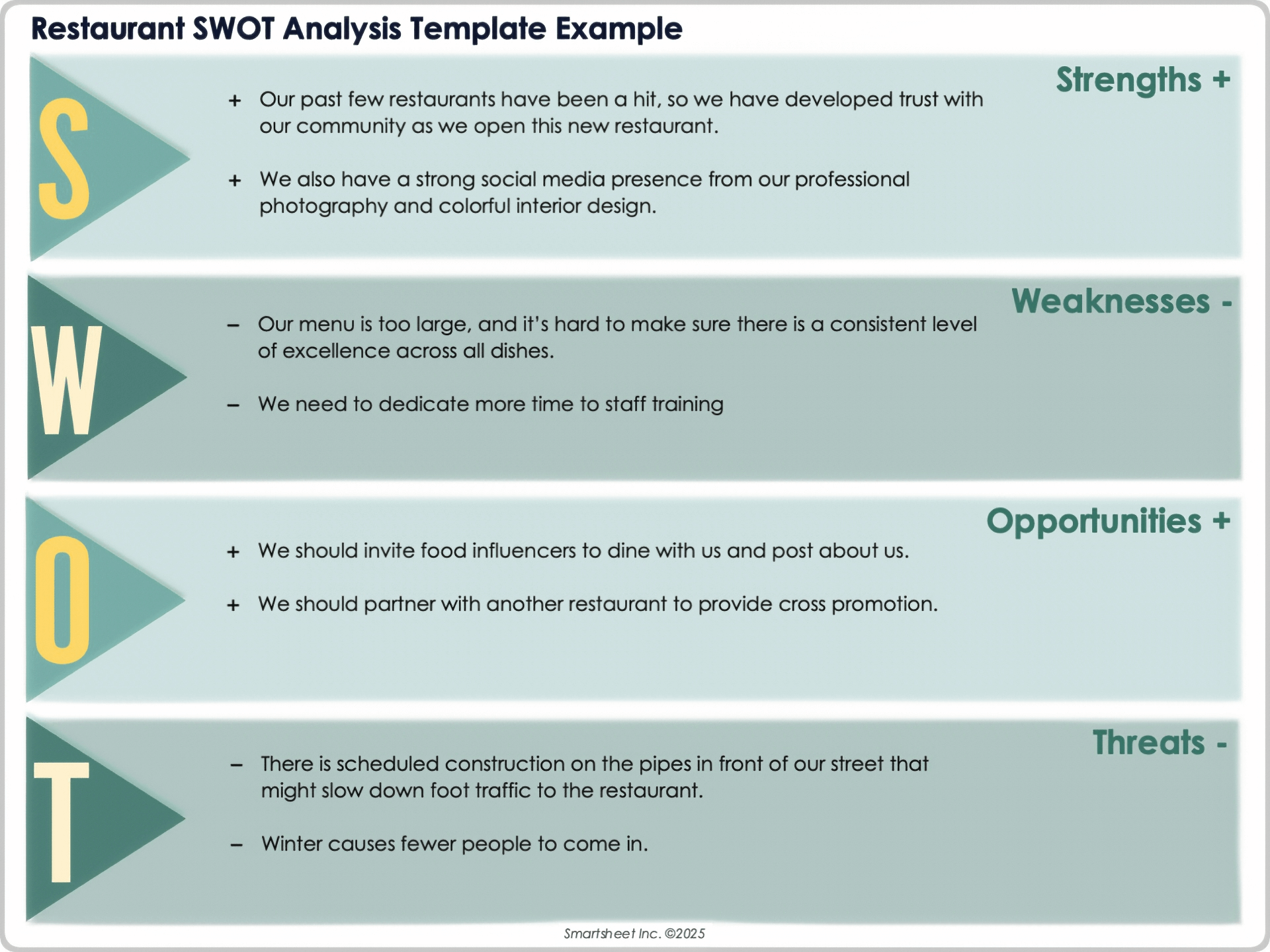
Download the Restaurant SWOT Analysis Template for Microsoft Word
Tech Startup SWOT Analysis Example
This animated tech startup SWOT analysis demonstrates the strengths, weaknesses, opportunities, and threats associated with a tech startup. The company is consistently growing their customer base, but employee retention is not good. Their forthcoming product version presents opportunities, but cybersecurity experts have said their product is vulnerable to emerging threats.
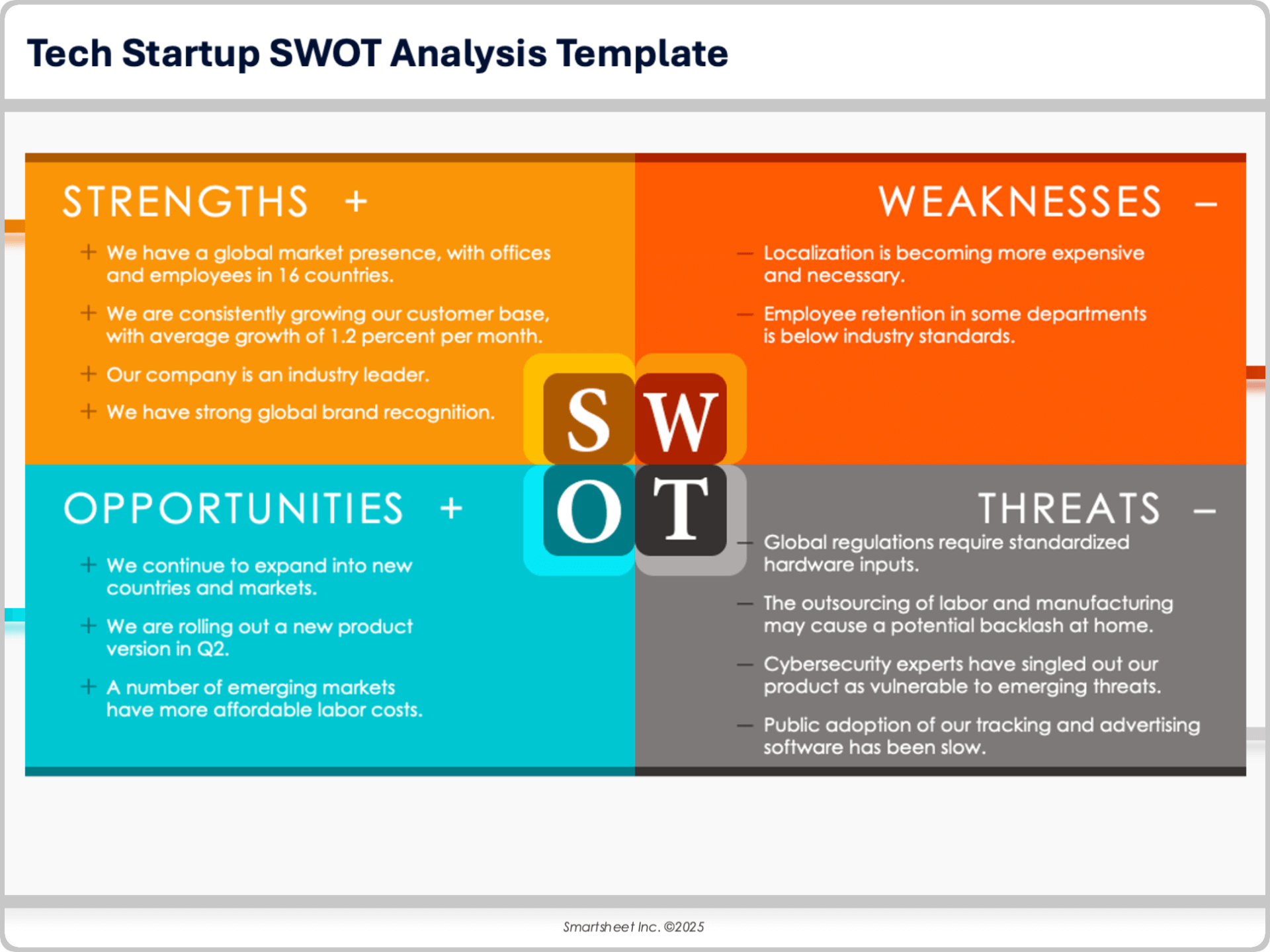
Download the Tech Startup SWOT Analysis Template for PowerPoint
Digital Marketing Agency SWOT Analysis Example
This digital marketing agency SWOT analysis demonstrates the strengths, weaknesses, opportunities, and threats associated with a small digital marketing agency. The company recently landed a big client, but the teams need further SEO training. They have an opportunity to reach out to new influencers, but a competing digital marketing agency has been attempting to poach clients.
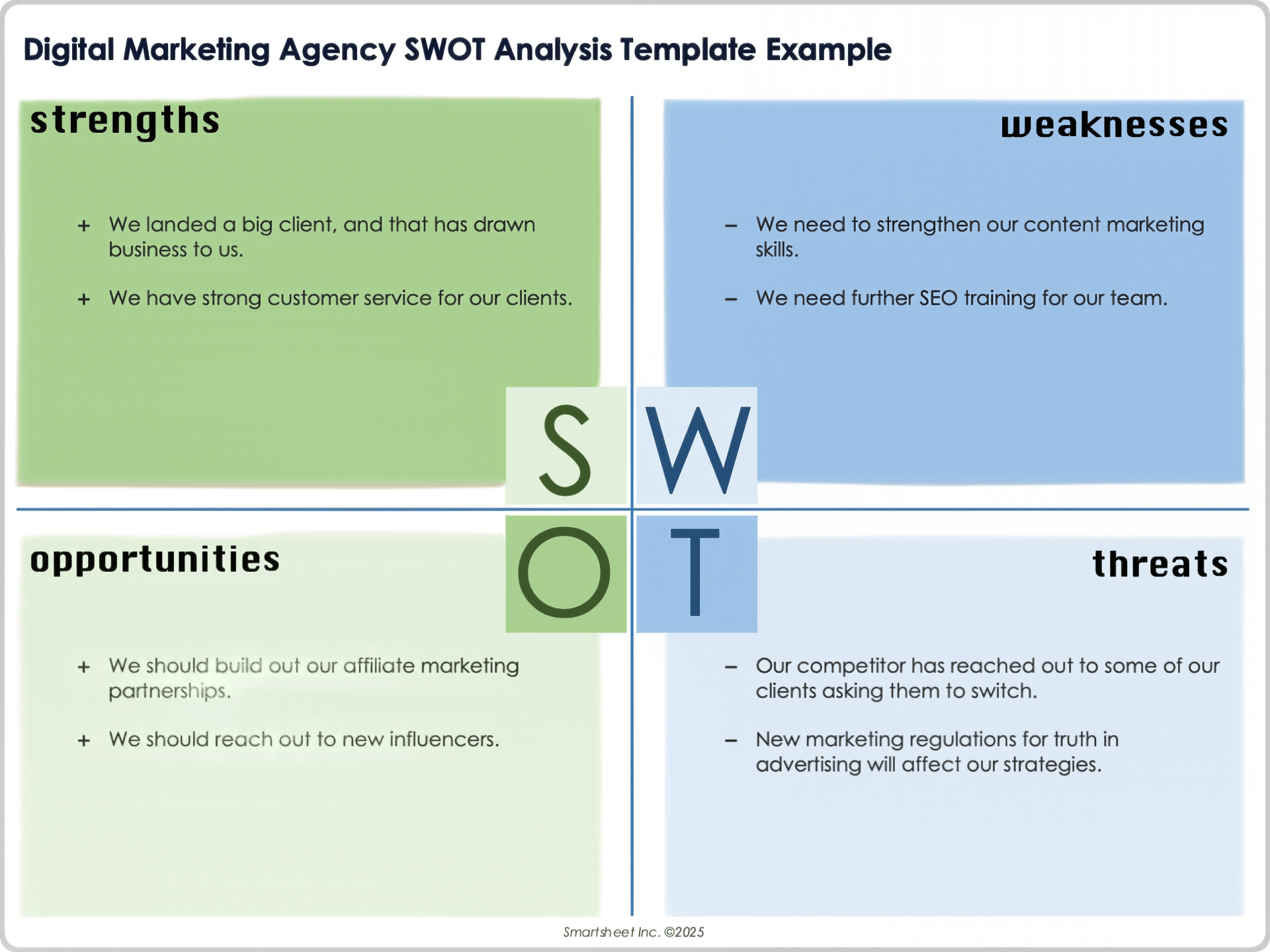
Download the Digital Marketing Agency SWOT Analysis Template for Microsoft Word
Nonprofit Organization SWOT Analysis
This nonprofit organization SWOT analysis demonstrates the strengths, weaknesses, opportunities, and threats associated with a small nonprofit. This organization has good communication with its beneficiaries and communities but not so much within the team. They have an opportunity to partner with local political organizations, but not being able to renew funding is a potential threat.
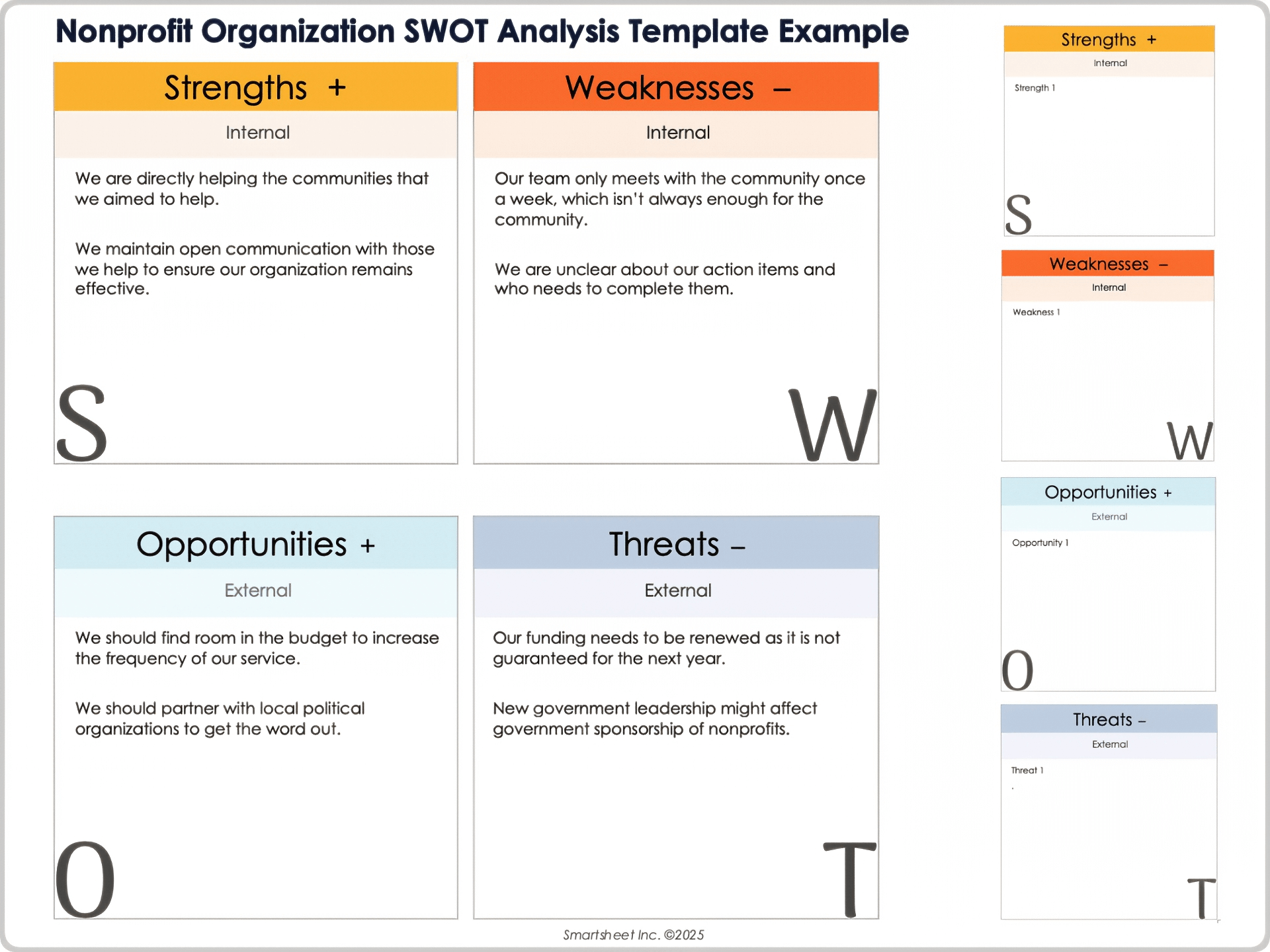
Download the Nonprofit Organization SWOT Analysis Template for Microsoft Word
Why SWOT Analysis Is Important for Small Businesses
SWOT analysis is important for small businesses mainly to keep eyes on all aspects of growth. Analyzing both internal factors (strengths and weaknesses) and external factors (opportunities and threats) can provide a detailed, holistic overview of your business and help you make informed decisions about long-term growth.
“The essence of a SWOT analysis lies in its ability to foster a balanced strategic vision. It encourages an equilibrium between optimism and realism,” says Jim Field. “It forces them to get out of the day-to-day details and think holistically about their business.”
A SWOT analysis can benefit a small business in several ways:
- Understanding Your Business Holistically: When you understand your business holistically, you can minimize blind spots and avoid being caught by surprise. For example, if you are focusing only on positive customer feedback, you might miss inefficiencies in your chain of command or workflow.
- Planning for Future Growth: SWOT analysis can help you see where you are and where you need to get to. For example, if you see that one of your weaknesses is customer service, you can invest in training for your customer service team.
- Building a Strategic Vision: SWOT analysis can help a business build a strategic vision by offering a clear picture of its current position and helping align goals with reality. For example, a business may be strong on digital marketing but have limited production capacity, leading to a strategic vision that focuses on sustainable scaling of its physical store and rapid expansion of its digital store.
- Identifying Local Opportunities: Small businesses can use SWOT analysis to help think about local strategy. For example, a small business might consider untapped local markets or demographics that would be interested in their product or service, and then make a marketing plan to target that market.
- Identifying Threats: SWOT analysis is a great opportunity to identify potential threats to your small business, and try to mitigate these threats through strategic planning. Jim Field says it’s important to pay attention to both internal and external threats. “Internal threats could include excessive reliance on a single client or inadequate business systems,” he says. “External threats might be new or more aggressive competitors or economic recession.”
- Locating Room for Improvement: Identifying weaknesses means identifying room for improvement, which is crucial to growing your small business. For example, if customer feedback indicates that the packaging for your product is unpopular, you can work on a redesign to make it more appealing.
- Expanding on Strengths: SWOT analysis shows where a small business can put more time, money, and strategy into what is working. For example, if you are getting a lot of sales from social media marketing, you can invest more resources in expanding your social media reach.
Learn more about how to develop a small business financial plan and use these small business plan templates as your guide.
Grow Your Small Business With Real-Time Work Management in Smartsheet
Empower your people to go above and beyond with a flexible platform designed to match the needs of your team — and adapt as those needs change.
The Smartsheet platform makes it easy to plan, capture, manage, and report on work from anywhere, helping your team be more effective and get more done. Report on key metrics and get real-time visibility into work as it happens with roll-up reports, dashboards, and automated workflows built to keep your team connected and informed.
When teams have clarity into the work getting done, there’s no telling how much more they can accomplish in the same amount of time. Try Smartsheet for free, today.


